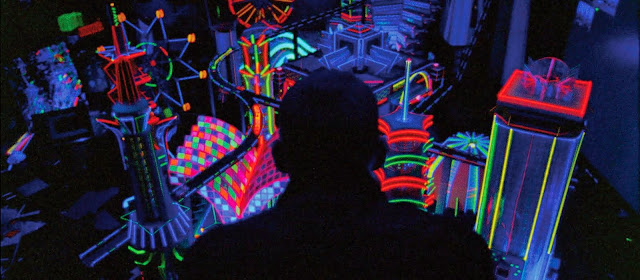Here's Andrew's review of Enter the Void. Enter........
With the release of Heaven is for Real, the topic
of the afterlife remains as fascinating and fantastic a place for filmmakers to
depict as it is for an audience to visit.
What happens to the soul in the post mortem state? Do we traverse the road markers of heaven or hell, with either angels flying amidst the clouds or minions wallowing in lava
and flames? Are our souls reincarnated
into new lives from whomever we choose?
With his third feature and dream project 'Enter the Void', French
provocateur Gaspar Noe attempts to turn the average view of the death
experience on its head by having its wandering spirit end up nowhere having
learned nothing.
 |
| "Every movie I'm in....on my back.. on my back...on my back...." |
Exploding onscreen with probably the most original title sequence in a great while, we're immediately bombarded with multicolored strobing credits designed to foreshadow the impending onslaught of visual eye candy tinged with Noe's singularly dark edge. Filmed almost entirely in the first person perspective, we see through the eyes of Oscar, a small time American drug dealer living in Tokyo, Japan with his stripper sister Linda. Oscar's vision is represented replete with screen blinking to reflect his eyesight, shots of him regarding his reflection in the mirror as he washes his face in between first-person drug induced head trips. On a drug deal gone wrong, Oscar loses his life and thus begins the film's journey into a post mortem netherworld of past experiences, present observations, and a gradual foray into 'the void', wherever that is. A loose travel guide through this surreal experience comes in the form of Alex, a junkie pal whose own obsession with the Tibetan Book of the Dead provides Oscar (and the audience) with an expectation of what Oscar might see when he dies.
 |
| "I like pretty colors...." |
Noe shifts
between 35mm filmstock for the present day sequences before switching to a
lower grade 16mm format for what will become known as the 'ghost-vision'
chapter, where Oscar's dead soul flies through buildings, high in the sky and
deep down through the sewers. The film
repeatedly shifts perspectives with respect to which death state Oscar is in,
often floating over the heads of characters from a bird's eye view, constantly
moving about back and forth. When we
witness Oscar's upbringing, the camera is carefully poised directly behind his
head for an entire chapter of the film.
Punctuating each chapter of Oscar's spiritual journey is a unique use of
editing, often breaking up Oscar's episodes with black screens in between shots
before shots are blended together digitally into simulated long takes, a
technique utilized in his previous film 'Irreversible' to suggest the film was
shot in a single take. Colors gradually
grow more exaggerated and artificial as Oscar careens further and further into
oblivion, until eventually we're at a loss as to describe what exactly we're
seeing.
Enter the
Void aims for the Douglas Trumbull psychedelia concluding Kubrick's '2001: A
Space Odyssey', as Oscar obsesses over the drug DMT and its proximity to
recreating the death experience. In
short, Oscar's death provides the ultimate trip. True to Noe's desire to provoke and upset,
the first person point of view grows steadily more transgressive as Oscar comes
into touch with his Oedipal yearnings. As Oscar's soul drifts further and further into infinity, the film
deliberately grows more hallucinatory and stroboscopic, assaulting the senses
as much as possible shy of inducing seizures within some viewers. The film has a strange mixture of unsimulated
sex with astonishing vistas of a Neo-Tokyo fever dream, making it one of the
prettiest visual effects movies you can't show to your children or
grandparents. When Noe isn't provoking
the viewer with graphic sexual content, he freely rubs the viewer's face deep
into some of the heaviest shocks since his first feature 'I Stand Alone', often
reverting back to his monochromatic gold camerawork for scenes involving a
young Oscar and Linda enacting a blood pact.
 |
| Look, honey. Trump is building a wall over there. |
Sound and
music itself is oppressive and brooding, often broadcasting a low ambient hum
in between ear piercing screams and deafening drum and bass electronica for
scenes of Oscar drifting through Tokyo's dance clubs. Word had it Thomas Bangalter of Daft Punk
(who scored Noe's previous effort 'Irreversible') was set to write the film's
score but was too busy working on 'Tron Legacy' and wound up providing Noe a
series of suggested preexisting pieces. In a unique feat of sound in the first half, we hear Oscar's inner
monologue as random thoughts about his relationship with Linda and a fellow junkie
pal named Alex. As Oscar's focus begins
to blur, so too does the soundscape, with faint distant voices growing ever
more disembodied and muffled.
Whatever
the case and whether the film truly works or not, Enter the Void's greatest
aim is to show a view of the afterlife that's never been seen before, neither
ending in Heaven or Hell. Though
stretched out to a painfully elongated 160 minutes (trimmed slightly for UK/US
releases), this is as close to capturing a soul disintegrating in motion as any
ever attempted before or since. While an
ostensibly heavy and draining experience, you won't see images like these
anywhere ever again. For some viewers,
it might be the heaviest film you will ever watch. For others, it's an enthralling journey which
moves confidently out of the safety net laid out by other filmmakers trying to
portray just what goes through the mind of a troubled soul as it leaves our
world on a journey to the next.
-Andrew Kotwicki
Like this review? Please share!

